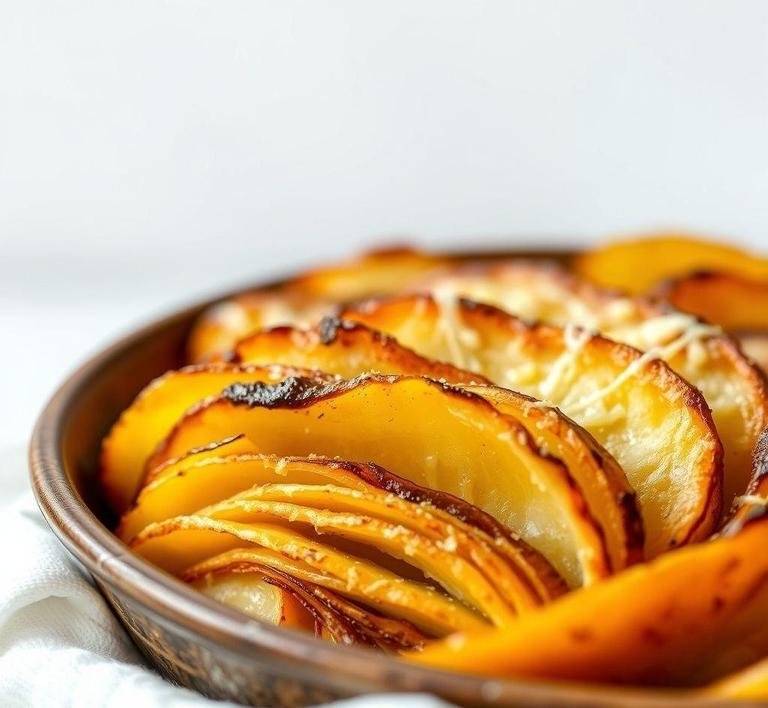Jamie Oliver’s Dauphinoise Potatoes is his twist on a classic French dish, gratin dauphinois. It’s a rich, creamy potato bake but with a few signature touches that elevate it. Think layers of tender potatoes cooked in a luscious mixture of cream, milk and garlic, baked until golden and bubbling. What Jamie does differently is the inclusion of fresh herbs, a hint of nutmeg and a nice touch of cheese. It’s a comforting side dish that pairs beautifully with a roast or any meal that calls for something indulgent.
Jamie Oliver Dauphinoise Potatoes Recipe
Ingredients Needed
Here’s a quick rundown of what you’ll need to create Jamie Oliver’s version:
- Potatoes: Choose waxy or floury potatoes (like Maris Piper or Yukon Gold). These hold up well and give the perfect balance of creaminess and structure.
- Double Cream: This adds a rich, velvety texture that makes the dish feel indulgent.
- Milk: Used to balance out the richness of the cream, making it just the right level of comfort without feeling overly heavy.
- Garlic: Freshly minced garlic brings that aromatic warmth to the dish. You can’t skip this!
- Nutmeg: A pinch adds depth and an unexpected warmth that makes the dish really pop.
- Cheese: Typically Gruyère or Parmesan, these cheeses melt beautifully and bring a slightly nutty flavor to the mix.
- Butter: To grease the baking dish and also add a bit of extra richness.
- Herbs: A few sprigs of thyme or rosemary add a lovely freshness that cuts through the richness of the cream.
Equipment Needed
You don’t need fancy equipment for this dish. Here’s what you’ll need:
- Sharp Knife or Mandoline: To slice the potatoes thinly and evenly.
- Grater: To grate the cheese.
- Baking Dish: A nice ceramic or glass dish works best. It holds the heat evenly and gives the dish a golden, crispy top.
- Pan (Optional): For heating the cream mixture before layering it with the potatoes.
- Oven: For that all-important golden, bubbly finish.
How To Make Jamie Oliver’s Dauphinoise Potatoes
- Prep the Potatoes: Start by peeling the potatoes and slicing them thinly. The slices should be about 1/8-inch thick – you want them to cook evenly and absorb the creamy sauce. If you’ve got a mandoline slicer, now’s the time to use it. It saves a lot of time and gives perfect slices.
- Flavor the Cream: In a saucepan, heat your double cream and milk together. Add in the garlic, a pinch of nutmeg and a good amount of freshly ground black pepper. If you like, you can throw in a sprig or two of thyme or rosemary at this stage to infuse the cream mixture. Let this simmer gently, allowing the flavors to meld together.
- Grease the Dish: Rub some butter on the inside of your baking dish. This helps prevent the potatoes from sticking and adds a bit of extra flavor. If you’re feeling fancy, you can also rub the garlic clove over the dish before buttering.
- Layer the Potatoes: Start layering the potato slices in your baking dish. Try to overlap them slightly, so they form a nice compact layer. After each layer, sprinkle a bit of cheese over the top. You can also add a little bit of salt and pepper to taste at each stage. Repeat this until all the potatoes are in the dish.
- Pour the Cream Mixture: Once all the potatoes are layered, pour the warm cream mixture evenly over the top. The cream should come up to just about the top of the potatoes but not cover them entirely. Give the dish a little shake to ensure everything is coated evenly.
- Bake: Place the dish in the oven and bake at around 180°C (350°F) for 45 minutes to an hour or until the top is golden and bubbly. The potatoes should be tender when pierced with a fork. If the top gets too dark, you can cover it with foil and continue baking until done.
- Finish and Serve: Let the dauphinoise potatoes rest for a few minutes before serving. This allows the cream to settle and the flavors to meld. Serve with your favorite main dish and prepare to be amazed.
What I Learnt

Making Jamie Oliver’s Dauphinoise Potatoes was a game-changer for me in terms of comfort food. Here’s what I picked up:
- Layering is Key: The layers of potatoes and cheese really do make a difference. It’s not just about adding the ingredients – the way you layer them helps achieve that melt-in-the-mouth experience.
- Don’t Skip the Garlic: The garlic is subtle but absolutely essential. It adds a depth that would be missing otherwise.
- Let It Rest: Just like with many other baked dishes, letting it sit for a few minutes after it comes out of the oven helps everything settle and thicken up.
- Adaptability: You can play around with the herbs or cheese. the recipe is flexible and can be adjusted to your taste. You can also experiment with using a bit of stock instead of milk for an added layer of flavor.
Recipe Tweaks For Jamie Oliver’s Dauphinoise Potatoes
Jamie Oliver’s dauphinoise potatoes are already pretty fantastic but if you’re looking to switch things up or add a personal touch, here are a few tweaks to consider:
-
Add Garlic and Herbs
Sure, Jamie’s version already brings the flavors but you can crank it up by adding more garlic! Sauté a few cloves in butter and pour that into your cream mix for a deeper, richer taste. Fresh thyme, rosemary or even a hint of sage could bring more complexity. Just sprinkle them between the layers of potatoes for that extra fragrant punch.
-
Cheese Variations
Traditionally, dauphinoise are all about that creamy, cheesy finish but why settle for just Gruyère? Try mixing it up with a combo of Gruyère and Parmesan for a sharper bite. Or even throw in a bit of sharp cheddar for some depth. You could also fold in a bit of blue cheese for a funky twist. if you’re into bold flavors.
-
A Dash of Spice
Want to kick it up a notch? Sprinkle in some nutmeg, cayenne pepper or smoked paprika. A pinch of nutmeg pairs really well with the creaminess while a little cayenne adds warmth without overwhelming the flavor.
-
Upgrade the Cream
Experiment with half-and-half or a blend of cream and crème fraîche for extra richness. If you want a lighter version, you could use whole milk instead of heavy cream, though it’ll change the texture a bit.
-
Add a Crunchy Topping
If you’re into textures, add a layer of breadcrumbs on top before popping it in the oven. You can toast them in a little butter and garlic for extra flavor. It’ll give you that golden, crispy top that contrasts beautifully with the soft, creamy potatoes underneath.
Storage Tips For Leftovers
After you’ve made a batch of Jamie Oliver’s dauphinoise potatoes, you’ll probably end up with some leftovers. Here’s how to make sure they stay delicious for later:
-
Cool Before Storing
Always let your dauphinoise potatoes cool down to room temperature before storing them. Hot food going straight into the fridge can raise the temperature in your fridge which can lead to bacteria growth. So, give them a little time to settle.
-
Airtight Containers
Store the leftovers in an airtight container to prevent them from absorbing other odors in the fridge. If you don’t have a container, wrapping them tightly in foil or plastic wrap works too.
-
Fridge Storage
Dauphinoise potatoes will last for about 3-4 days in the fridge. Reheat them properly before serving; a quick blast in the oven will help retain the texture of the creamy layers and crispy top.
-
Freezing for Longer Storage
You can freeze dauphinoise potatoes if you want to store them for longer. Just make sure they’re fully cooled before transferring them to a freezer-safe container. They’ll keep for about 1-2 months in the freezer. When you’re ready to eat them, thaw them in the fridge overnight and reheat in the oven for the best results.
-
Reheating Tips
To reheat, place the potatoes in an oven preheated to 350°F (175°C). Cover them with foil for the first 15 minutes to prevent drying out. After that, remove the foil and let the top crisp up for another 10-15 minutes.
What To Eat With Jamie Oliver’s Dauphinoise Potatoes?
Dauphinoise potatoes are a decadent, rich side dish, so you’ll want something to balance them out. Here are a few ideas:
-
Roast Meat
Classic pairing: roast beef, lamb or chicken. The creamy, cheesy potatoes complement the savory, roasted flavors perfectly. A simple herb-crusted roast lamb or a juicy roast chicken with garlic and rosemary would be a match made in heaven.
-
Grilled Fish
If you’re looking for something lighter, dauphinoise potatoes go really well with grilled fish. Think along the lines of salmon, cod or even sea bass. The richness of the potatoes is cut through by the fresh, delicate flavor of the fish.
-
Steamed Vegetables
To balance out all that creaminess, serve some crunchy, lightly steamed veggies on the side. Broccoli, green beans or asparagus work wonders. You could even sauté them in a bit of butter for extra flavor.
-
Salad
A fresh, zesty salad with a tangy dressing can really bring balance. Try a simple arugula or mixed greens salad with a lemony vinaigrette or even a beetroot salad with goat cheese.
-
Wine Pairing
Don’t forget a nice glass of wine! A crisp white like Chardonnay or Sauvignon Blanc can cut through the richness. If you prefer red, a light Pinot Noir or a medium-bodied Merlot will also do the trick.
FAQs
What Makes Jamie Oliver’s Dauphinoise Potatoes Special?
Jamie’s recipe uses cream, garlic, and a touch of nutmeg, which gives the potatoes a rich, velvety texture and a comforting flavor.
Can I Make Jamie Oliver’s Dauphinoise Potatoes Ahead Of Time?
Yes, you can assemble the dish a day ahead, then bake it when you’re ready to serve. Just cover it with foil to keep it fresh.
What’s The Best Type Of Potato To Use For Dauphinoise Potatoes?
Waxy potatoes like Yukon Gold or Charlotte work best because they hold their shape while cooking, giving you that creamy texture without falling apart.


